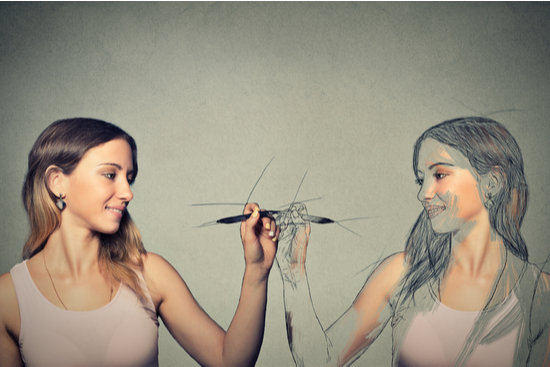How to stop feeling uncomfortable
“How can we ever know what we’re truly capable of if we’re not trying to do what we don’t think we can, every single day? And that means being afraid, and doing it anyway.” – Siri Lindley
As humans, we’re wired for comfort. It’s all too easy to marathon Netflix instead of working out or stick with what you know instead of learning a new skill. But our brains are also wired to crave growth. Without growth, we’ll never truly be happy – and without learning how to get comfortable being uncomfortable, we’ll never truly grow.
In a Tony Robbins podcast, world champion triathlete Siri Lindley talks about working with legendary coach Brett Sutton and pushing herself to limits beyond she thought possible. She says, “Yes, you’re going to be afraid of failing, you’re going to be afraid of being rejected, but you’ve got to do it anyway.”
Learning how to be comfortable being uncomfortable isn’t just for athletes – it can benefit you in your career, your relationships and your personal goals. You’ll need to identify the source of your discomfort, embrace the emotions you’re feeling, reframe your experience in a positive light – and repeat until you build up your tolerance to discomfort.
Identify
There are plenty of reasons we feel uncomfortable every day. The first step to getting comfortable being uncomfortable is to identify the cause. This may seem easy: Your boss expects you to give a presentation with no advance warning. You’re in a new relationship and you’re not sure where it’s going. You’re learning a new skill or sport – and failing.
To get comfortable being uncomfortable, you need to dig deeper. When we feel uncomfortable, the real reason is often vulnerability. You feel vulnerable getting in front of a client without preparation. You feel vulnerable in your new relationship. Your inevitable failures when you’re learning a new skill make you feel vulnerable, too.
Researcher Brené Brown has spent decades studying vulnerability. She says, “Vulnerability is not winning or losing; it’s having the courage to show up and be seen when we have no control over the outcome.” When you’re able to identify its true source, you’ll be able to get comfortable being uncomfortable – and start showing up and being seen.
Embrace
Vulnerability is deeply related to one of the strongest of Tony’s Six Human Needs: certainty. When we feel vulnerable, we feel uncertain. Will we be accepted? Are we worthy of love? Letting go of our need for certainty isn’t easy. It begins with learning to embrace reality in all its imperfection. Author and speaker Byron Katie often says, “When you argue with reality, you lose – but only 100% of the time.”
To get comfortable being uncomfortable, stop arguing with reality. Accept that there are things that are out of your control. As Katie says, “There is no such thing as a ‘should’ or a ‘shouldn’t.’ These are only thoughts that we impose onto reality.” There’s no point in arguing with the rain or teaching a cat to bark. It’s either raining or it isn’t. Cats meow. There is no point in saying, “This shouldn’t be happening.”

Rather than argue with reality, be grateful for it. Tony says that “When you are grateful, fear disappears and abundance appears.” Discomfort is a form of fear. Replacing it with gratitude for the moment – no matter what – will help you get comfortable being uncomfortable.
Reframe

You can’t question reality, but you can question the way you react to it. Changing your mindset is the most essential key to unlocking how to get comfortable being uncomfortable. Our beliefs create our emotions, and our emotions create our world.
It starts with asking questions. Byron Katie says, “I don’t let go of my concepts – I question them. Then they let go of me.” Question your need for certainty. It’s true that it allows you to feel stable and safe, but it also inhibits growth, another of the Six Human Needs. If you’re not growing, you’re dying, and that’s no way to live your life.
Uncertainty and vulnerability are the biggest catalysts for change. In her famous TED Talk, Brené Brown said, “Vulnerability is the birthplace of joy, creativity, of belonging, of love.” When you begin to think of it that way, you’ll replace limiting beliefs with empowering ones and open the door to feeling comfortable being uncomfortable.
Repeat
Practice makes perfect – and that especially applies if you want to get comfortable being uncomfortable. The feeling of discomfort and even fear when you do something new actually triggers a special part of your brain. It releases dopamine, the “reward molecule,” to tell your body that this new experience is good for you. This creates a cycle that reinforces itself: You do new things, you feel good, so you do more new things. Before you know it, you’re totally comfortable being uncomfortable.
Repeating uncomfortable situations also forces your body and your mind to get used to them. This is why top athletes like Siri purposely push themselves past their limits. Navy SEALs undergo Basic Underwater Demolition/SEALs (BUD/S) training, in which they spend long periods of time in cold water. Tony himself does cold plunges, as well as a 15-minute morning workout routine that brings him to near total exhaustion.
To get comfortable being uncomfortable, you have to be willing to be uncomfortable. It’s the only way to grow – personally, professionally and romantically. Set a goal right now to do something today that makes you uncomfortable, and you’ll be on your way to unlocking your unlimited potential.
Ready to get comfortable being uncomfortable?
Start identifying your deeper emotions by examining your limiting beliefs and replacing them with empowering ones. This guide will get you started.